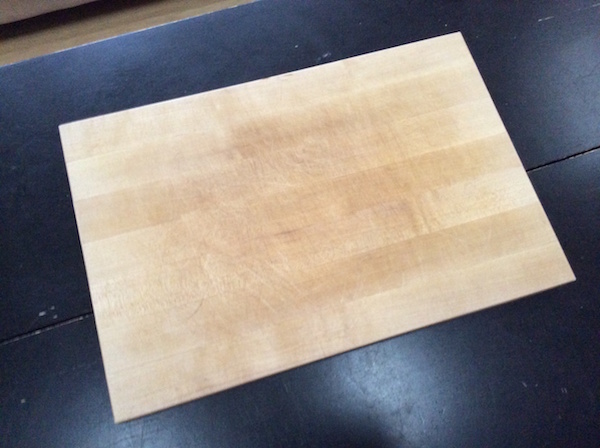Cutting boards are a quick woodworking project that can be done with scrap pieces of wood you have leftover from other projects. They make great gifts, they can double as serving boards and are easy to make. But before you start making your own, there are some cutting board design considerations you should keep in mind.

1. Size
This is probably the most basic issue, and depends on what you intend the cutting board to be used for and your particular kitchen. A cutting board for a turkey or a large roast will need to be larger than a cutting board used for slicing and presenting cheese for snacks. Likewise, a cutting board that is too large to fit into your sink for washing is one that won’t get used very often.
One good place to check sizes are stores that sell items for cooking and kitchens. See what sizes of cutting boards are being offered. They can serve as a guideline for the size of your particular cutting board.
2. Thickness
This is an aspect of cutting boards that is often overlooked. Cutting boards that are going to serve light duty and be used as presentation pieces can afford to be thinner. Workhorse cutting boards that are going to be used every day in a busy kitchen will benefit from being thicker. Be aware, however, that cutting boards that are too thick may raise the food high enough off the countertop that chopping becomes uncomfortable. Again, checking the thickness of commercially available cutting boards can be a useful guide.
3. Grain orientation
One advantage of making a cutting board out of smaller pieces of wood is that you will have more control over the grain orientation of the board. In this cutting board, I deliberately cut and oriented the individual pieces of wood so that the grain ran vertically through the thickness of the board.

There is a reason for this. I knew that this cutting board would be used a lot. Wood tends to shrink and expand due to humidity and moisture changes in a direction tangential to the grain. This cutting board will shrink and expand in thickness, but not in width. For a wooden item that will be exposed to a lot of moisture and liquid, as the cutting board is used for chopping and being washed, this will help prevent the board from splitting in the future.
On the other hand, if you have a very figured piece of wood, it may be better to leave the figure in place so as to not spoil the beauty of the grain. This type of board would be better as a serving piece to be used occasionally, rather than as an everyday user.
3. Wood species
Certain woods are better for cutting boards than others. Woods that are hard, don’t have pores or open grain, and are dense are good choices for cutting boards. Some species that can be used include maple, cherry, beech, and hickory. Walnut can be used, depending on the individual board, but it does have slightly open grain which may make washing an issue. Oak and ash are less than ideal for this purpose.
4. Aesthetics
Here’s where you can let your individuality and taste shine. Although most cutting boards are rectangular, you can make them round, triangular, or any shape that you want. You can add a handle, or not. Likewise, you may decide to add a hole for hanging the cutting board, or leave it plain. Have fun with this part — a cheese board in the shape of a mouse could be a cute idea for a novelty project.
In addition, you can use the wood that you will be using for your cutting board as a design element. Mixing two contrasting woods can lead to interesting designs in an otherwise plain rectangular cutting board.
The sky’s the limit as far as designs for your cutting board goes. Look at magazines, cooking websites, and any other food-oriented resource you have for inspiration.
In upcoming articles, we will make a small cutting board that will also serve as a serving piece, and learn some techniques using planes and rasps to help shape the cutting board.


Share tips, start a discussion or ask one of our experts or other students a question.
No Responses to “Board Basics: Cutting Board Design Considerations”